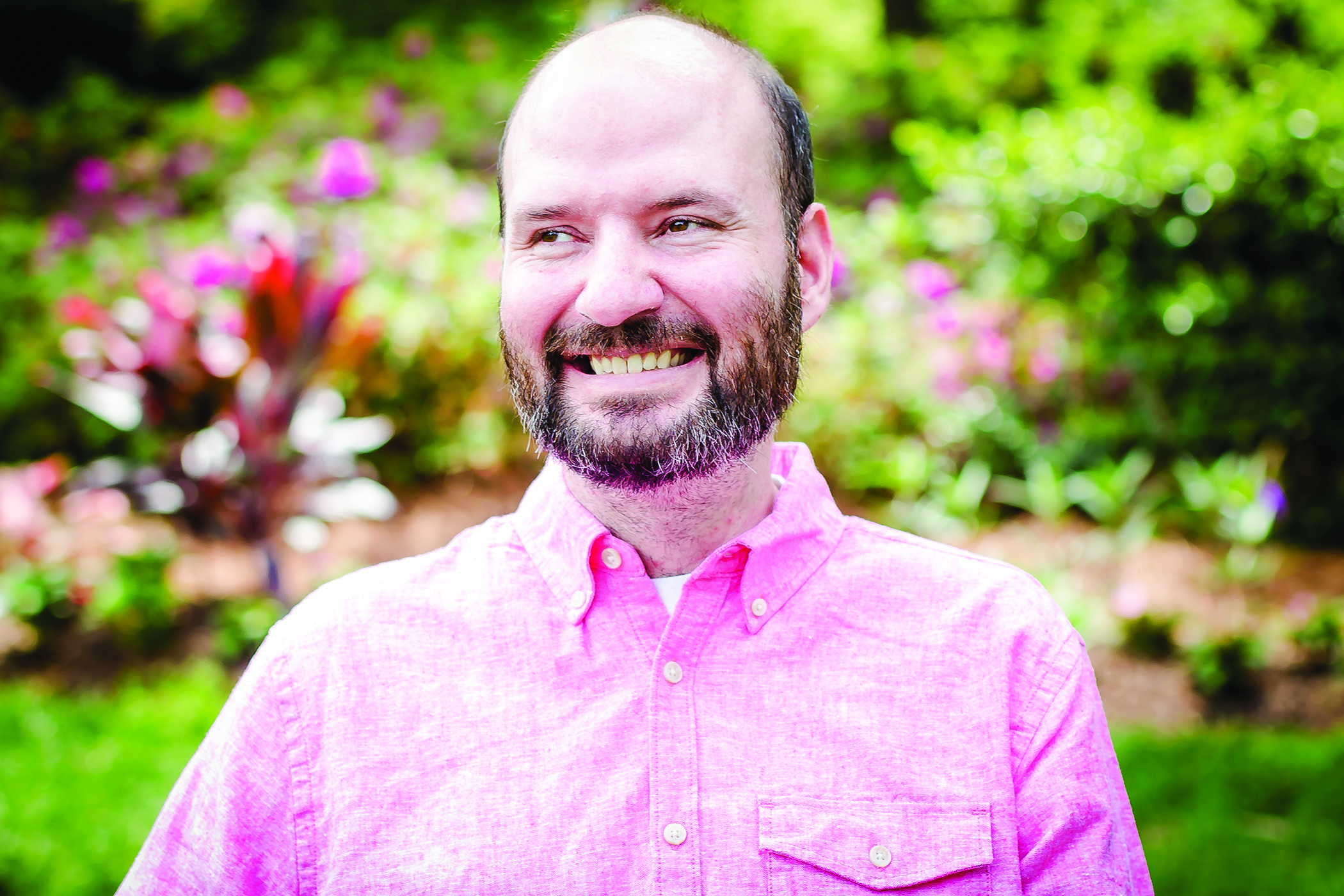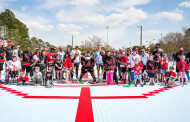Like so many others, every morning Michael Bereman wakes up, gets dressed, kisses his wife and children good bye and heads to work. Sounds pretty ordinary, right? Well, there is nothing ordinary about Michael Bereman, or the work that he is doing. As an Assistant Professor in the Department of Biological Sciences at NC State University, Michael is not just shaping young minds, he is searching for answers. Answers that he hopes will save lives, maybe even his own.
After graduating from NC State in 2004 and receiving his PhD in Analytical Chemistry, in 2009, Michael was offered his dream job teaching at his beloved alma mater. In January of 2015, Michael, his wife, Meagan, and their one-year-old son, Mason, were living in Apex and enjoying being a young family. That January, Michael noticed a twitching in his left arm. “He chalked it up to carpal tunnel syndrome from all the time on the computer doing his research,” Meagan said. Then, after six months of visits to different doctors and numerous testing for everything from zinc deficiency to mercury poisoning, just three days before his 34th birthday, Michael was diagnosed with amyotrophic lateral sclerosis or ALS. ALS is a progressive neurodegenerative disease that affects nerve cells in the brain and the spinal cord.
The Diagnosis
According to the ALS Association, the initial symptoms of ALS can vary from person to person, but typically involves a gradual onset of generally painless and progressive muscle weakness. ALS can be difficult to diagnose because it can mimic so many other diseases. In fact, ALS is commonly diagnosed by exclusion of other diseases first.
The typical diagnosis time for ALS is a year to a year and a half. Because of Michael’s background in research and his determination to find out what was wrong, his diagnosis came in just six months. “Michael was an amazing advocate for his own health,” Meagan said.
In fact, Michael had his suspicions long before the doctors confirmed his diagnosis. “He was googling his symptoms, like we all do, and he said ‘I think I have ALS.’ I told him there was no way he had that because he was too young,” Meagan recalled. In a way, Meagan was right. Michael did not fit into the “typical” ALS mold. ALS usually strikes between the ages of 40 and 70, and at age 34, ALS was not a top suspicion by his doctors. But what Michael and Meagan found out was that ALS is not an old person’s disease. “You have to work your way up to an ALS diagnosis,” Michael said.
Michael’s doctors performed an EMG, or electromyography, which assesses the health of muscles and nerve cells that control them. “After we had the EMG done, we were praying for one of the ‘excluded’ illnesses or known mimics to be the cause,” Meagan said. But unfortunately, the EMG confirmed all of their suspicions. “They said I was completely healthy, except for ALS,” Michael said.
A Choice to Make
Now that Michael had his diagnosis, he had a choice to make. Should he retire, like so many do, or should he take his talent, knowledge and experience and once again be an advocate, not only for himself but for all those suffering from ALS? He chose to work. Over the past 3 and a half years since his diagnosis, Michael has been working tirelessly alongside students and colleagues to answer questions about ALS in hopes of finding a path to early detection and diagnosis, and ultimately, a cure.
There are two types of ALS, sporadic, meaning it can affect anyone, and familial, meaning a family member has also been diagnosed. Of the over 20,000 Americans with ALS, 90% of those cases are sporadic, meaning there is no family history of the disease. Researchers believe there may be an environmental link to ALS. Michael’s research is focused on looking at cyanotoxins and determining if there is a link between these toxins and ALS. Cyanotoxins are produced by bacteria called cyanobacteria, more commonly known as blue-green algae. Anyone who has been on a lake knows that algae is found throughout nature. Michael’s research has found that there are key proteins in the brain that contain neurotoxins, or toxins that are destructive to nerve tissue, and some of these neurotoxins are produced by the cyanobacteria or algae. If Michael and his team can find a link between these environmental factors and ALS, they hope they can someday find a cure for this horrible disease.
But this type of research doesn’t come cheap. Michael has received several grants for his research, including a grant from the ALS Association to look for markers in diagnosing ALS, including looking at CSF, or cerebrospinal fluid, for indications of ALS. All of this research will hopefully help in finding ways of diagnosing ALS earlier, which would give patients a chance to start treatment earlier and help their quality of life.
In addition to the difficulty in diagnosing ALS, there are no concrete ways to measure the progression of the disease. “There is no way to measure except for me telling you what I can do,” Michael said. Patients are given a Functional Rating Score which is a series of questions such as, are you able to feed yourself, or dress independently. “These tests are all subjective,” Michael said. There are no blood tests to determine the progression. “But if we had a marker to determine ALS, we could also use that marker to determine progression,” Michael explained.
Michael’s lab, along with a lab at the University of North Carolina, recently received a grant from the Department of Defense to research a new drug for ALS. “The only known risk factors for ALS is age, sex (slightly higher risk in males), family background (which is low), and being in the military,” Michael said. The Department of Defense is a major funder of ALS research because of the number of veterans and those in the military that have contracted ALS. One of the theories is that the toxins, stress and excessive exercise that members of the military encounter could be a link to ALS.
Finding a Community
Throughout their journey with ALS, Michael and Meagan have found a support network of those in similar situations battling ALS, and what they found is that they aren’t alone. “There are at least 10 families in this area in the same situation with young children,” Meagan said. “We now know that we aren’t as rare as we thought,” she said.
Together these families are fighting every day to find answers, raise funds and raise awareness. You may recall the social media craze of the ice bucket challenge. What you may not recall is that this was actually a fundraiser for ALS research. Although this challenge was often times a way to make people laugh, the result was anything but comical. The ice bucket challenge raised over $115 million for ALS research. So, to all those that endured this chilly challenge, just know that your discomfort was all for a wonderful cause.
May is ALS awareness month, and on April 20 the local chapter of the ALS Association will hold its annual ALS walk. Each year, Team Bereman Brave walks to support the association and helps to fund the research that Michael holds so dear to his heart. “Last year we raised $10,000 for the ALS Association,” Meagan said. “ALS isn’t an incurable disease, it is underfunded,” Michael added.
A New Purpose
Michael’s research is not only important to the ALS community, it has also given the Beremans a new sense of hope and purpose. Although Michael is doing the legwork in his fight against ALS, this family of four (Mason is now 4 and daughter Millie is 2) is fighting together to bring the same hope and purpose to those around them.
Meagan’s constant smile and positivity is contagious, and Michael’s determination and perseverance are inspiring to all those he comes in contact with.
Although ALS attacks the bodies of those diagnosed, it can take a toll on the ones they love. All you have to do is watch Michael and Meagan interact, and you will see the love that is in a simple look or laugh or a gentle touch to know that although ALS may rob them of experiences and abilities, it won’t rob them of their love and support for one another and for their family.








